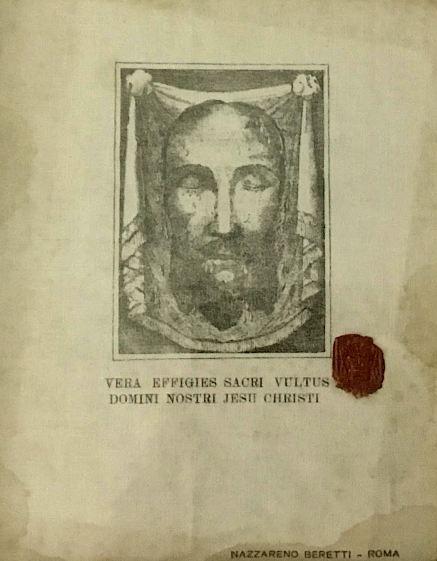
The True Effigy of the Holy Face
Relics of the true effigy of the Holy Face originate with the 19th century miracle that had occurred with the Veil of Veronica[1] kept at the Basilica di San Pietro, Vatican City (Cruz, 2015). The Veil, which the pious woman[2] had given to Jesus Christ at the top of the steep hill located between al-Wad Road and the Souq Khan al-Zeit (Sacred Destinations, 2019), so that He could wipe away the Blood and sweat pouring down His Face while carrying the Cross, had been taken to Rome by Saint Veronica herself during the reign of the Emperor Tiberius.[3]
In 1849, during the revolution that had occurred at the time of Saint Pius IX, the Veil of Veronica was on display for veneration after Vespers on the 5th Sunday in Lent[4] (Cruz, 2015). All of a sudden, it was transfigured in front of everyone present. The Face of Christ appeared as though it was lifelike. It was also surrounded with a halo of soft golden light, while the Veil itself glowed with the divine light in front of everyone present.
The miracle lasted for three hours and one the Canons of Saint Peter was ordered by the Pope to draw the Holy Face as it had appeared transfigured in order to preserve it for posterity (For All the Saints, 2009). Saint Pius IX also ordered that the Canon’s drawing of the Holy Face be engraved as an effigy onto linen cloths that would be touched to the original Veil of Veronica, a relic of the True Cross and the tip of the spear of Longinus,[5] making them precious relics in themselves, not just devotional images (Archconfraternity of the Holy Face, 1887). These effigies were to bear the official wax seal of a Cardinal of the Catholic Church and imprinted with the textual description:
VERA EFFIGIES SACRI VULTUS DOMINI NOSTRI JESU CHRISTI[6]
The true effigies of the Holy Face are known to have been distributed for a period of about 75 years. Above is a photograph of the effigy of the Holy Face that comes from Rome.
———-
[1] One of the few images of the Holy Face not made by human hands (Cannuli, 2014).
[2] Originally named Seraphia (Doyle, 2000) and commonly known as the pious woman, she became identified as Veronica in the apocryphal Gospel of Nicodemus (Reid, 1913), because of the imprint of His Face that Christ had left on her Veil in gratitude for her merciful gesture.
[3] Tiberius was the Roman Emperor from 14 AD to 37 AD.
[4] Previously known as Passion Sunday.
[5] Longinus had pierced Christ’s side with the spear after His death. This relic is also housed at the Basilica di San Pietro, Vatican City.
[6] True Image of the Holy Face of Our Lord, Jesus Christ.

